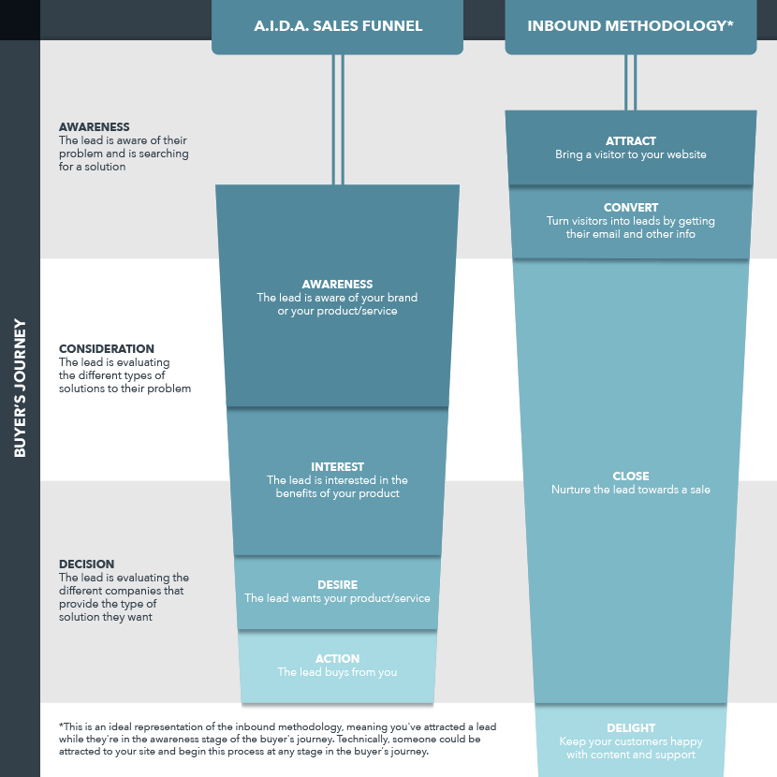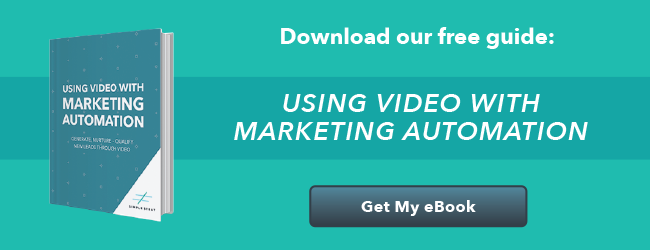Most of us in marketing and sales are after one thing: more closed sales. Oh, and if we could get that additional revenue without adding to our crazy workload or tight marketing budget, that would be nice too right?
Well, leveraging the power of video marketing is one way to make that happen. By creating video content that is strategically designed to move your leads through the sales funnel, you can get more leads, close more sales, and even save time and money along the way.
Before we get into how to do that, let’s take a step back and briefly review what the sales funnel stages are.
What are the sales funnel stages?
The concept of a sales funnel has been around since 1898, long before digital marketing or even TV ads for that matter. Since that time, new names and similar models with subtle differences have arisen. You may have heard of some of these alternate terms and models, such as the buyer’s journey, purchase funnel, or customer journey.
Still, the overarching concept hasn’t changed much in the last 120 years or so. The idea is that potential customers go through a series of stages before purchasing from you, and that each stage has a smaller number of leads at any given time than the one before it as people drop out of your sales process for one reason or another.
What those stages are will vary depending on what model you’re looking at, and many companies build a custom funnel for their specific sales process. But all of these models are based on and similar to the stages originally identified in 1898:
- Awareness – Prospects first become aware of your product/service.
- Interest – Prospects become interested in the benefits of your product/service.
- Desire – Prospects desire your product/service.
- Action – Prospects buy your product/service.
There have been three adaptations to this model since its creation that are important to note.
The first is the addition of a stage after action, often called “delight.” This stage highlights the importance of keeping your customers happy so that they make repeat purchases and/or become a mouthpiece advocating for your company to other potential customers.
The second modification worth noting is the buyer’s journey model. While its stages are similar to the sales funnel, it looks at things from the buyer’s perspective and begins before a prospect is even aware of your product or service. Its stages are:
- Awareness – Prospects become aware that they have a problem they want to solve.
- Consideration – Prospects evaluate the different types of solution for their problem.
- Decision – Prospects decide whether your company is the best vendor of their chosen type of solution.
Finally, there is the inbound funnel coined by HubSpot that is essentially the original sales funnel with updated terminology for digital marketing. Its stages are:
- Attract – Attracting qualified visitors to your website.
- Convert – Converting those visitors to leads by getting their information (at least email address).
- Close – Turning those leads into customers through lead nurturing and sales.
- Delight – Keeping your customers happy through additional content and support.
Here’s how the stages of each of the models above fit together:

Why use video at all?
So now that we have our heads wrapped around the sales funnel stages, let’s talk about why we should use video to move customers through those stages. We wrote a detailed post about the benefits of video marketing if you’d like to check it out.
For now, let’s just touch on a few key reasons why we’re fans of video at Simple Strat:
- Different people like to consume content in different ways. Some people want to read it, some want to listen to it, and some want to watch it.
- Video can build trust and create a more authentic connection to your audience. When people see you on camera, they’re more likely to think of you as a real person than just a part of some company.
- Video is proven to work. In a recent Aberdeen Group research report, they found that companies using video reduce the length of their sales cycle by 4.3 times.
What types of video should you use at each stage?
Alright, so how exactly do we use video to effectively move leads through the sales funnel stages? It’s all about mapping the right types of video to the right stage. In other words, you want to give your prospective customers the videos that will be most helpful to them at the stage they are currently in.
We like to use the buyer’s journey model to map content since it includes stages before a client even knows your company exists. As a reminder, the buyer’s journey stages are awareness, consideration, and decision.
Pro Tip: The best way to actually get these videos into people’s hands at the right time is to use automation. For more about that, we recommend reading our free eBook: Using Video with Marketing Automation.
Awareness
At the awareness stage of the buyer’s journey, people are becoming aware of their problem and are seeking out solutions. To effectively help people at this stage, you’ll want to create educational videos that help people solve the same problems that your products or services solve. However, you should resist the urge to just create a video telling them to solve their problem by buying from you. This is NOT the time for a sales pitch.
For example, let’s say you’re creating video for a fitness center. At the awareness stage, your potential customers might be realizing that they’d like to lose weight. So, they might begin to look for solutions to that problem online. If they see a video telling them to lose weight by joining your gym, they’re likely to ignore it. They simply aren’t ready for it yet. Instead if they see a video about 5 quick daily exercises they could do (perhaps in a gym), you’re helping them solve their problem and you’re establishing yourself as a trusted thought leader.
At this stage, you should be creating videos such as how-to videos, tutorials, guides, etc. Anything focused on educating your audience about how to solve their problems is appropriate. For more details on all the types of video your business may need in its arsenal, check out our post on The 8 Essential Types of Video for Business.
Consideration
At the consideration stage, people are evaluating the potential types of solutions they could use to solve their problems. At this stage, we want to start steering them to your company by showing how your products or services could help them at a high level.
Going back to our fitness center example, someone at the consideration stage might be trying to determine whether they should buy a home workout tape and some basic equipment or join a gym. They’re still not quite ready to hear about how great your gym is, but they are ready to hear about the benefits of joining a gym in general.
At this stage, you should be creating videos such as high-level product overviews, brief animated explainer videos, or information/educational content that focuses more on how your type of solution solves their problem.
Decision
The decision stage is the one most sales people love. Your leads have selected a type of solution they want to buy, now they just need to pick a vendor. In our gym example, they know they’ll be joining a gym, they just don’t know which one yet.
Here’s where you finally get to make your pitch.
At the decision stage, you want to deliver videos that prove your value. Case studies and testimonials are great. In-depth product demos and your more traditional video advertisements work well too.
Pro Tip: Add some video content to your FAQ page as this is an often neglected but valuable resource for your potential customers as they make their decision.
Bonus: Delight
Even though the delight stage isn’t technically part of the buyer’s journey model, it’s not one you want to ignore. Happy customers buy more from you and spread the word. Unsatisfied customers disappear and bad-mouth you whenever they get the chance.
Some videos you can use after the sale include welcome videos or meet-the-team videos that could be used in your onboarding process, detailed tutorial videos about how to use your products, and other videos that answer support questions. If there’s a question your support team gets all the time, send back a nice video instead of a canned email. It takes a little more work but just imagine the difference in experience that your customer will have.
Next Steps
Now that you know which types of video you should use at each stage, start by thinking about one video you could create for each stage. Better yet, if you already have video assets, categorize them by the stage they fit in. Then, come up with a strategy for delivering the videos to people when they’re in the corresponding stage. That may include marketing automation, social media, email marketing, online advertising, and/or specific pages on your website.
This all probably sounds like a lot of work. That’s because it is. But, once you have your video assets in place and your delivery strategy nailed down, things become much easier than they were before. So get to it; we promise you and your boss will be thanking you later!

